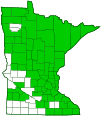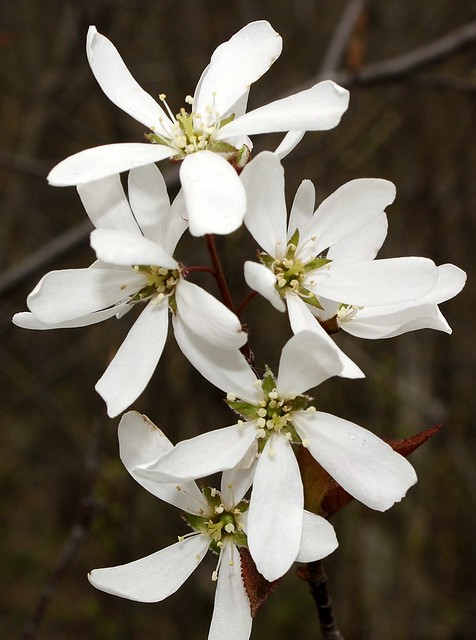pin cherry
(Prunus pensylvanica)
Conservation • Wetland • Description • Habitat • Ecology • Use • Distribution • Taxonomy
Description |
||
Pin cherry is common from New England to the upper Midwest and across southern Canada, uncommon and scattered west of the Great Plains. It is common throughout Minnesota except for the southwest quarter. This is a small, fast-growing, short-lived, deciduous tree. It rises on a single stem from a shallow, spreading root system. Most roots are within 24″ of the soil surface. In other areas it can be from 10′ to 45′ in height and up to 20″ in diameter at breast height. In Minnesota it is usually no more than 25′ tall and 8 ″ in diameter. It reproduces mostly by root sprouts and often forms thickets. In forests, it rarely germinates, and when it does, the saplings rarely survive except in large openings with plentiful moisture and light. Seedlings mostly appear in a forest after heavy cutting, burning, or a blow down. They mature rapidly and live only 20 to 40 years. The trunk is fairly straight and sometimes leaning. The crown is narrow and rounded at the top. The branches on young trees are ascending. As the tree ages, the branches become nearly horizontal. The bark on young trees is thin, smooth, shiny, and dark reddish-brown with numerous conspicuous, long, horizontal, pore-like openings (lenticels). The lenticels are widely-spaced, raised, warty, and orange. As the tree ages the bark turns gray. On mature trees the bark is rough and sometimes peels in horizontal strips, and the lenticels are rougher and darker. The twigs are very slender, hairless, shiny, and red or reddish-brown, with tiny, orange, dot-like lenticels. They are covered with a grayish skin at first but that quickly wears off. They have brown pith and a disagreeable bitter almond taste. The leaf scars are half-round to elliptical. They have 3 bundle scars . Lateral buds are small, 1 ⁄16″ to ⅛″ long, rounded, and reddish-brown. They diverge slightly from the twig. The terminal bud is similar and appears with a cluster of two or more lateral buds at the end of the twig. The leaves are deciduous, alternate, and clustered at the ends of the twigs. They are on ⅜″ to ¾″ long, hairless leaf stalks (petioles). The petioles often have one to three, more often two, small, red, wart-like swellings (glands) near the tip where the petiole meets the blade. The leaf blades are lance-shaped, 1¾″ to 4¾″ long, and ⅝″ to 2″ wide, 2 to 3 times longer than wide. They are broadly angled or rounded at the base and taper to a long point at the tip with concave sides along the tip. The upper surface is shiny, hairless and dark yellowish-green. The lower surface is paler and usually hairless, sometimes hairy along the main veins at first, becoming hairless. The margins are finely and irregularly toothed all the way to the base with sharp or rounded, forward pointing teeth. There is a small red or yellow gland at the tip of each tooth near the sinus. In autumn the leaves turn yellow. The inflorescence is 2 to 5, sometimes 6 or 7, flowers in an stalkless umbrella-shaped (umbel-like) or flat-topped cluster (corymb) at the end of a short, 1 ⁄32″ to 5 ⁄16″long, branch-like base (fascicle). The clusters appear at the ends of current year twigs and at the axils of previous year branchlets. Each flower is on a hairless, ⅜″ to ¾″ long flower stalk (pedicel). Each pedicel is subtended by a minute, modified leaves(bracts). The flowers open in early May to mid-June when the leaves are about half size. Each flower is about ½″ in diameter. There are 5 sepals, 5 petals, 10 to 30 stamens, and 1 style. The sepals are green, 1 ⁄32″ to ⅛″ long, untoothed, hairless, and bent backward. The petals are white, ⅛″ to ¼″ long, and conspicuously narrowed at the base (clawed). The claw is about 1 ⁄32″ long. The expanded portion of the petal is elliptic, inversely egg-shaped, or almost circular. The stamens have white filaments and yellow anthers. The fruit is a fleshy, one-seeded, spherical or ellipse-shaped, ¼″ to ⅜″ in diameter drupe. It is green at first, turning bright red, shiny, and very sour when it matures in early July to late mid-August. The seed is not flattened. |
||
Height |
||
10″ to 45″ |
||
Record |
||
There is no current champion pin cherry tree in Minnesota. |
||
Flower Color |
||
White |
||
Similar Species |
||
American plum (Prunus americana) bark is gray. The branches have stout spines. There are only 2 to 4 flowers or fruits per umbel. Black cherry (Prunus serotina var. serotina) mature bark is thick, dark, blackish, and scaly. The leaves are dark green above, not yellowish-green. The leaf tip is not a drawn out point. The inflorescence is a 3″ to 6″ long cluster of 20 to 60 flowers. |
||
Habitat |
||
Dry to moderate moisture. Open forests, forest edges and openings, streamsides, roadsides, burned-over and other disturbed areas. Shade intolerant. |
||
Ecology |
||
Flowering |
||
Early May to mid-June |
||
Pests and Diseases |
||
Cherry Leaf Spot (Coccomyces hiemalis) |
||
Use |
||
|
||
Distribution |
||||
|
Sources |
|||
| 5/25/2023 | ||||
Nativity |
||||
Native |
||||
Occurrence |
||||
Common |
||||
Taxonomy |
|||
| Kingdom | Plantae (Plants) | ||
| Division | Tracheophyta (Vascular Plants) | ||
| Subdivision | Spermatophytina (Seed Plants) | ||
| Class | Magnoliopsida (Dicots) | ||
Order |
Rosales (Roses, Elms, Figs, and Allies) | ||
Family |
Rosaceae (Rose) | ||
| Subfamily | Amygdaloideae | ||
| Tribe | Amygdaleae | ||
Genus |
Prunus (Plums, cherries, and Allies) | ||
| Subgenus | Cerasus (true cherries) | ||
| Section | Cerasus | ||
Subordinate Taxa |
|||
Some sources, including USDA PLANTS, recognize two varieties based on leaf shape and dentation: the nominate variety, Prunus pensylvanica var. pensylvanica, common in eastern United States and across southern Canada; and P. p. var. saximontana, occurring scattered west of the Great Plains. Flora of North America (FNA) considers the differences to be within normal variation, and does not recognize the varieties. Most sources follow FNA’s example. |
|||
Synonyms |
|||
Cerasus pensylvanica Prunus corymbulosa Prunus pensylvanica ssp. corymbulosa Prunus pensylvanica var. corymbulosa Prunus pensylvanica var. pensylvanica Prunus pensylvanica var. saximontana |
|||
Common Names |
|||
bird cherry fire cherry pin cherry red cherry |
|||
Glossary
Bract
Modified leaf at the base of a flower stalk, flower cluster, or inflorescence.
Corymb
A flat-topped or convex inflorescence in which the stalked flowers grow upward from various points on the main stem to approximately the same horizontal plane. The outer flowers open first.
Drupe
A fleshy fruit with a single hard, stone-like core, like a cherry or peach.
Fascicle
A small bundle or cluster, often sheathed at the base, as with pine needles.
Filament
On plants: The thread-like stalk of a stamen which supports the anther. On Lepidoptera: One of a pair of long, thin, fleshy extensions extending from the thorax, and sometimes also from the abdomen, of a caterpillar.
Lenticel
A corky, round or stripe-like, usually raised, pore-like opening in bark that allows for gas exchange.
Pedicel
On plants: the stalk of a single flower in a cluster of flowers. On insects: the second segment of the antennae. On Hymenoptera and Araneae: the narrow stalk connecting the thorax to the abdomen: the preferred term is petiole.
Petiole
On plants: The stalk of a leaf blade or a compound leaf that attaches it to the stem. On ants and wasps: The constricted first one or two segments of the rear part of the body.
Umbel
A flat-topped or convex, umbrella-shaped cluster of flowers or buds arising from more or less a single point.
Visitor Photos |
|||||
Share your photo of this plant. |
|||||
| This button not working for you? Simply email us at info@MinnesotaSeasons.com. Attach one or more photos and, if you like, a caption. |
|||||
Luciearl |
|||||
I had several trees/shrubs that came down in heavy winter weather. Both of these bloomed and had fruit on them, although nearly knocked to the ground. |
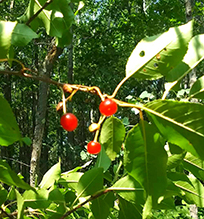 |
||||
Discovered this tree in my woods and believe it is Pin Cherry. |
|||||
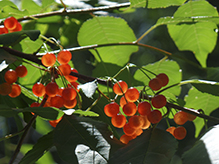 |
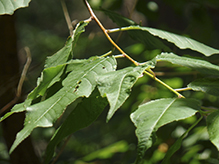 |
||||
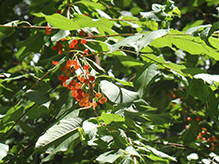 |
|||||
MinnesotaSeasons.com Photos |
|||||
Tree |
|||||
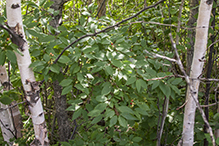 |
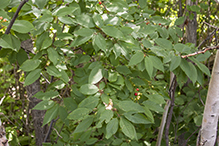 |
||||
Leaves |
|||||
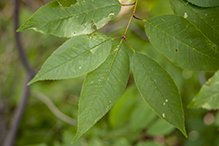 |
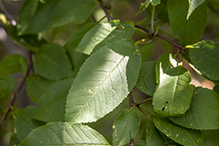 |
||||
Twig |
|||||
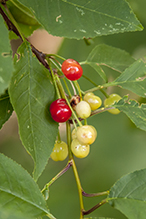 |
|||||
Fruit |
|||||
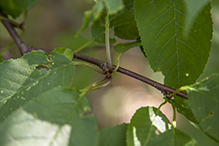 |
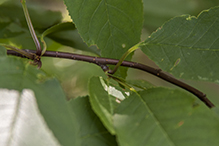 |
||||

Visitor Videos |
|||
Share your video of this plant. |
|||
| This button not working for you? Simply email us at info@MinnesotaSeasons.com. Attach a video, a YouTube link, or a cloud storage link. |
|||
Other Videos |
|||
| Trees with Don Leopold - pin cherry ESFTV |
|||
About
Published on Jun 27, 2012 |
|||
| Tree Identification: Pin Cherry alabama woodsman |
|||
About
Published on Apr 22, 2016 Learn how to identify Pin Cherry and what it can be used for. |
|||
| Wild edibles: Pin Cherry UrbanSurvivalTactics |
|||
About
Published on Sep 12, 2013 Warning: Never eat anything you find without proper knowledge. |
|||

Visitor Sightings |
|||||
Report a sighting of this plant. |
|||||
| This button not working for you? Simply email us at info@MinnesotaSeasons.com. Be sure to include a location. |
|||||
| Luciearl 7/9/2023 |
Location: Fairview Twp. I had several trees/shrubs that came down in heavy winter weather. Both of these bloomed and had fruit on them, although nearly knocked to the ground. |
 |
|||
| Luciearl 7/11/2018 |
Location: Cass County Discovered this tree in my woods and believe it is Pin Cherry. |
 |
|||
MinnesotaSeasons.com Sightings |
|||||

Created: 7/20/2018
Last Updated:
